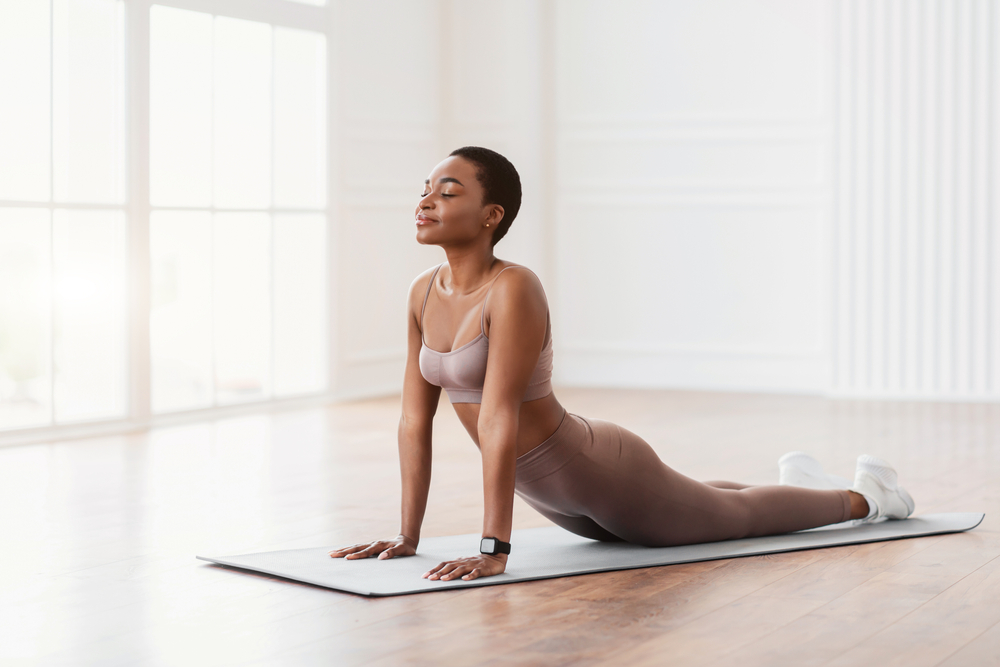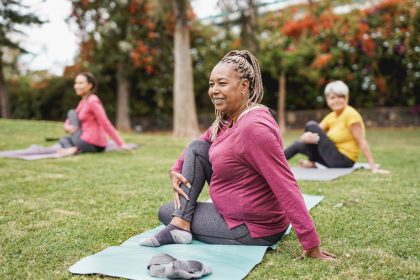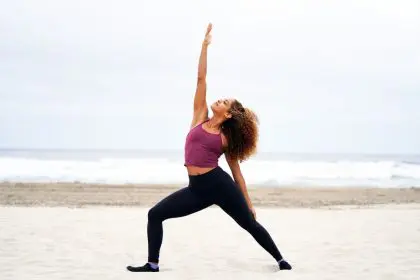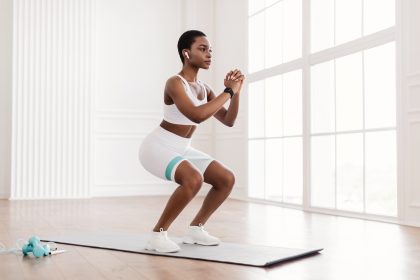These targeted exercises can correct years of posture problems in just minutes a day while strengthening key muscle groups
Poor posture has become increasingly prevalent in modern society, with extended periods of sitting, constant device use, and sedentary lifestyles contributing to alignment issues that cause pain and impair function. While posture correction might seem daunting, particularly for those who have spent years with rounded shoulders or forward head positioning, the right exercises can produce noticeable improvements surprisingly quickly. This comprehensive guide explores five highly effective exercises that target the most common posture problems, requiring minimal time and equipment while delivering significant results when performed consistently.
Wall angels for upper back alignment
Wall angels represent one of the most effective exercises for correcting rounded shoulders and forward head posture, common issues resulting from prolonged sitting and computer use. This exercise activates the often-neglected muscles between the shoulder blades while stretching tight chest muscles, creating the perfect combination for upper body realignment.
The first step involves proper positioning against a wall. Stand with your back against a flat wall, feet about six inches away from the baseboard. Press your lower back, upper back, shoulders, and head against the wall surface, maintaining these five contact points throughout the exercise. This starting position immediately places your spine in proper alignment, providing a physical template for correct posture.
The second phase focuses on the arm movement pattern. With your back properly positioned against the wall, bend your elbows at 90-degree angles and place the backs of your forearms against the wall, resembling a goal post or “W” position. From this starting position, slowly slide your arms upward along the wall while maintaining contact between your forearms and the wall surface. Continue until your hands reach overhead or as high as possible while keeping the five contact points against the wall.
The third component involves proper execution for maximum benefit. Move your arms slowly and with control, focusing on squeezing your shoulder blades together as you slide upward. Many people initially find they cannot maintain wall contact with their forearms while keeping their back properly positioned—this identifies exactly where postural weakness exists. Start with 3 sets of 8-10 repetitions daily, gradually increasing as strength improves. Most people notice significant shoulder repositioning within two weeks of consistent practice.
Chin tucks for neck alignment
Chin tucks specifically target forward head posture, an increasingly common problem often called “text neck” due to its association with mobile device use. This seemingly simple movement powerfully realigns the cervical spine while strengthening the deep neck flexors that maintain proper head positioning throughout the day.
The first execution method involves seated chin tucks. Sit tall in a chair with your shoulders relaxed and spine neutral. Without tilting your head upward or downward, gently draw your chin straight back, creating a “double chin” effect. Think of your head moving straight back horizontally rather than nodding up or down. Hold this retracted position for 3-5 seconds before releasing. This movement might seem subtle, but it precisely activates the deep cervical flexors that counterbalance the overactive neck extensors pulling the head forward.
The second approach incorporates chin tucks into daily activities. Practice performing the same gentle chin retraction while walking, working at your desk, or standing in line. These “posture check-ins” serve as both corrective exercises and reminders to maintain alignment throughout daily activities. Set phone reminders every hour to perform 5-10 chin tucks to build consistency.
The third technique involves supine chin tucks for deeper activation. Lie on your back without a pillow, knees bent and feet flat. In this position, perform the same chin retraction movement, gently pressing the back of your neck toward the floor. This variation adds gravity resistance while providing feedback through floor contact. Begin with 3 sets of 10 repetitions twice daily. Most individuals report noticeable improvements in neck alignment and reduced neck tension within 7-10 days of consistent practice.
Doorway chest stretches for shoulder realignment
Tight chest muscles significantly contribute to rounded shoulders and forward posture by pulling the shoulder joint forward and creating muscular imbalance. The doorway chest stretch effectively addresses this tightness while providing immediate postural improvement and creating space for proper shoulder positioning.
The first stretching position targets the pectoralis major. Stand in an open doorway with your forearms positioned on either side of the door frame, elbows bent at 90-degree angles at shoulder height. Your forearms and palms should rest against the door frame in an “L” position. From this starting position, gently lean forward through the doorway until you feel a substantial stretch across your chest and front shoulders. Hold for 30 seconds while maintaining proper core engagement and avoiding excessive arching in your lower back.
The second position variation adjusts arm height to target different portions of the chest muscles. After completing the first stretch, lower your arms to a 45-degree angle below shoulder height and repeat the forward lean, stretching the upper chest fibers. Then perform a third variation with arms positioned slightly above shoulder height to target the lower chest fibers. This three-position approach ensures comprehensive stretching across all parts of the chest musculature.
The third component involves proper breathing during the stretch. Take slow, deep breaths while in the stretched position, attempting to expand your chest against the stretch with each inhale. This breathing technique enhances tissue mobility and increases stretch effectiveness. Perform this three-position stretching sequence 2-3 times daily, particularly before and after long periods of sitting. Most people experience immediate shoulder repositioning after stretching, with cumulative effects becoming noticeable within 5-7 days of consistent practice.
Glute bridges for pelvic alignment
Anterior pelvic tilt—characterized by an exaggerated curve in the lower back and protruding abdomen—significantly impacts overall posture and contributes to back pain. This common postural deviation often results from weak gluteal muscles combined with tight hip flexors. Glute bridges effectively address both issues simultaneously while teaching proper pelvic positioning.
The first step focuses on proper starting position. Lie on your back with knees bent and feet flat on the floor, positioned hip-width apart approximately 12 inches from your glutes. Place arms at your sides with palms down for stability. Before initiating any movement, find your neutral spine position by gently rocking your pelvis forward and backward until you locate the middle ground where your lower back has a slight, natural curve without excessive arching or flattening.
The second phase involves the lifting movement with proper muscle activation. From neutral spine position, exhale as you press through your heels and squeeze your glutes to lift your hips toward the ceiling. The key focus must remain on gluteal activation rather than using the lower back muscles. At the top position, your body should form a straight line from shoulders to knees. Avoid overextending at the top, which engages the lower back rather than the glutes.
The third component addresses common execution mistakes. Many people rush through this exercise, missing its postural benefits. Instead, lift slowly (2-second count up), pause for 2-3 seconds at the top while actively squeezing the glutes, then lower slowly (4-second count down). This tempo maximizes muscle activation and body awareness. Begin with 3 sets of 10-12 repetitions daily, focusing on quality rather than quantity. Most individuals notice improved pelvic positioning and reduced lower back tension within 1-2 weeks of regular practice.
Bird dogs for core stabilization
Core weakness contributes significantly to poor posture by failing to provide adequate spinal support during daily activities. The bird dog exercise builds essential core stability while simultaneously teaching proper spinal alignment and promoting balanced muscle development across the entire torso.
The first setup establishes proper quadruped positioning. Begin on your hands and knees with hands directly under shoulders and knees under hips. Engage your core by gently drawing your navel toward your spine without flattening your back completely. Maintain a neutral spine position where your back remains flat without sagging or arching. This starting position itself serves as a postural exercise by establishing proper spinal alignment.
The second phase incorporates contralateral limb movements. While maintaining core engagement and a stable spine, simultaneously extend your right arm forward and left leg backward until both are parallel to the floor. Focus intensely on preventing any rotation or tilting in your hips or shoulders—they should remain level as though balancing water on your back. Hold this extended position for 3-5 seconds before returning to the starting position and repeating with the opposite arm and leg.
The third component involves progression through proper breathing patterns. Coordinate your breath with the movement by inhaling during the setup phase and exhaling during limb extension. This breathing pattern enhances core activation and stability. As strength improves, increase difficulty by extending the hold time to 8-10 seconds or adding small pulses at the extended position. Begin with 3 sets of 8-10 repetitions on each side, practicing daily. Most people experience improved postural endurance and reduced back fatigue within 10-14 days of consistent practice.
Daily implementation for rapid results
While each exercise provides specific benefits, their true power emerges through strategic daily implementation. Creating a structured approach ensures consistency while maximizing results in minimal time. The following implementation strategies transform these individual exercises into a comprehensive posture correction system.
The first strategy involves morning realignment. Create a 5-minute morning routine performing one set of each exercise upon waking. This morning sequence “resets” your postural alignment before daily activities and stresses begin affecting your positioning. The morning timing takes advantage of the spine’s natural flexibility after sleep, allowing more effective repositioning.
The second approach incorporates micro-sessions throughout the day. Set reminders to perform one specific exercise for 1-2 minutes every 2-3 hours. For example, perform chin tucks at 9:00 AM, doorway stretches at 11:00 AM, wall angels at 1:00 PM, and so on throughout your day. These micro-sessions counteract the postural damage accumulated during prolonged sitting or standing periods, preventing regression while maintaining awareness.
The third component involves evening reinforcement. Complete a more comprehensive session in the evening, performing 2-3 sets of each exercise with full focus on form and muscle activation. This evening session helps counteract the cumulative postural stress from the day while reinforcing proper alignment before sleep. The combination of morning reset, daytime micro-sessions, and evening reinforcement creates a powerful framework for rapid postural correction, with most people experiencing visible improvements within 7-14 days of consistent implementation.
Advanced techniques for enhanced results
Once basic execution of these five exercises becomes comfortable, several advanced techniques can accelerate postural correction and enhance long-term results. These modifications don’t require additional time but significantly increase exercise effectiveness through subtle adjustments to existing movements.
The first advancement involves mental visualization during exercise performance. Rather than mechanically performing the movements, actively visualize your spine lengthening, your shoulders settling into their proper sockets, and your head balancing effortlessly atop your spine. This mind-muscle connection dramatically improves movement quality and carryover into daily posture. Imagine a string pulling upward from the crown of your head, creating space between each vertebra as you perform each exercise.
The second technique incorporates proprioceptive feedback tools. Simple implements like foam rollers placed vertically along the spine during glute bridges or small balls squeezed between the shoulder blades during wall angels provide tactile feedback that enhances body awareness and correct positioning. This sensory input helps your nervous system recognize and maintain proper alignment more effectively than movement alone.
The third advancement involves rhythmic breathing patterns coordinated specifically with each exercise. Beyond basic inhale-exhale timing, focus on breathing into the areas being stretched or activated. For example, during doorway stretches, visualize your breath expanding your chest three-dimensionally against the stretch. This breathing technique enhances tissue mobility and nervous system regulation, accelerating postural adaptation.
Implementing these five targeted exercises with consistency and proper form creates the foundation for significant postural improvement, often within weeks rather than the months or years many people expect. While severe postural deviations resulting from years of poor habits may require longer correction periods, most individuals experience noticeable changes relatively quickly, with decreased pain and improved appearance serving as powerful motivation for continued practice. By addressing the specific muscular imbalances underlying common postural problems, these exercises efficiently restore proper alignment while enhancing overall function and comfort in daily life.















